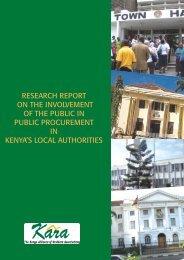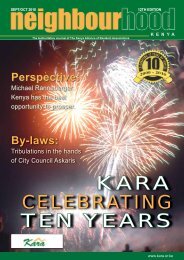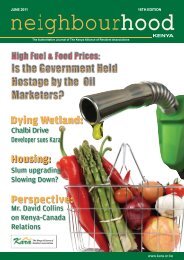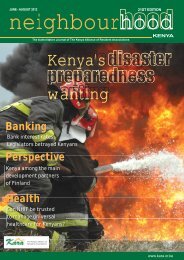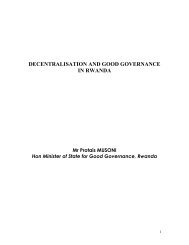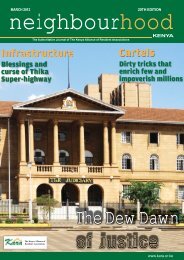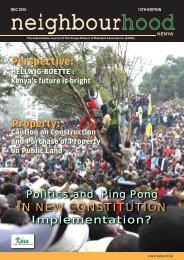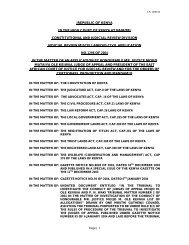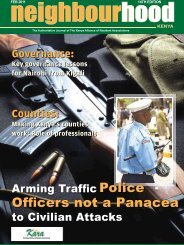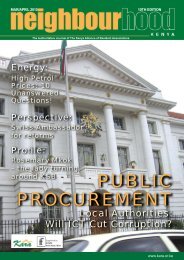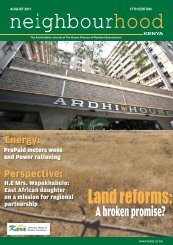Download : Devolution & County blueprints - The Kenya Alliance of ...
Download : Devolution & County blueprints - The Kenya Alliance of ...
Download : Devolution & County blueprints - The Kenya Alliance of ...
Create successful ePaper yourself
Turn your PDF publications into a flip-book with our unique Google optimized e-Paper software.
<strong>Devolution</strong><br />
& <strong>County</strong><br />
<strong>blueprints</strong><br />
Cross-Cutting Lessons
Kara-UNDP Amkeni Wakenya Initiative<br />
2<br />
<strong>Devolution</strong> and <strong>County</strong> Blueprints<br />
Cross-Cutting Lessons
Table <strong>of</strong> contents<br />
Kara-UNDP Amkeni Wakenya Initiative<br />
Introduction......................................................................................................................... 4<br />
Kara/UNDP Amkeni Wakenya initiative ............................................................................. 4<br />
Linking <strong>County</strong> <strong>blueprints</strong> to <strong>Kenya</strong>’s development agenda .......................................... 5<br />
<strong>The</strong> necessity for a <strong>County</strong> blueprint ................................................................................ 6<br />
Benefits <strong>of</strong> a <strong>County</strong> blueprint .......................................................................................... 7<br />
Pilot <strong>County</strong> <strong>blueprints</strong> ....................................................................................................... 8<br />
- Kericho <strong>County</strong> ........................................................................................................ 9<br />
- Embu <strong>County</strong> ........................................................................................................... 10<br />
- Kakamega <strong>County</strong> ................................................................................................... 10<br />
- Kajiado <strong>County</strong> ......................................................................................................... 11<br />
- Garissa <strong>County</strong>.......................................................................................................... 11<br />
- Nairobi <strong>County</strong> ......................................................................................................... 12<br />
Values and principles ......................................................................................................... 13<br />
Lessons learned .................................................................................................................. 13<br />
Citizen participation: Roles and responsibilities ..............................................................14<br />
Other cross-cutting issues ............................................................................................... 15<br />
Natural resources matrix ................................................................................................. 16<br />
Conclusion .......................................................................................................................... 16<br />
Acknowledgement<br />
We appreciate our partners UNDP, Amkeni Wakenya and all those individuals who<br />
made this publication a great success. We trust it will <strong>of</strong>fer value as <strong>Kenya</strong>ns usher in a<br />
completely new and exciting chapter- devolution!<br />
Stephen Mutoro<br />
CEO, KARA and Chairman, DEGONSA<br />
<strong>Devolution</strong> and <strong>County</strong> Blueprints<br />
Cross-Cutting Lessons<br />
3
Introduction<br />
Kara-UNDP Amkeni Wakenya Initiative<br />
<strong>County</strong> governments will come into being immediately after the forthcoming<br />
general elections. <strong>The</strong> enabling legislation will be in place as outlined in the<br />
Constitution <strong>of</strong> <strong>Kenya</strong> 2010 (CoK 2010). <strong>The</strong> overarching objective <strong>of</strong> creating<br />
devolved governments is to give powers <strong>of</strong> self-governance to the people and to<br />
enhance their participation in making decisions affecting them.<br />
<strong>The</strong> expected outcome <strong>of</strong> devolution is the promotion <strong>of</strong> socio-economic<br />
development and the provision <strong>of</strong> proximate, easily accessible services throughout<br />
<strong>Kenya</strong>. <strong>County</strong> governments will have the mandate to provide policy framework and<br />
the enabling environment for political, economic and social development players to<br />
deliver services to the citizens in accordance with the spirit <strong>of</strong> the CoK 2010.<br />
<strong>The</strong> adoption <strong>of</strong> the CoK 2010 and the concept <strong>of</strong> devolution were based on a<br />
promise <strong>of</strong> development to the people <strong>of</strong> <strong>Kenya</strong>. <strong>The</strong> Constitution represents a<br />
fundamental paradigm shift in the philosophy <strong>of</strong> governance. It adopts a philosophy<br />
founded on solidarity, and a developmental framework informed by the concept <strong>of</strong><br />
financial equalization. 1 <strong>The</strong> development framework includes generation <strong>of</strong> more<br />
wealth and expansion <strong>of</strong> the common basket by exploitation <strong>of</strong> the potential <strong>of</strong><br />
previously neglected areas. Field visits to counties by the <strong>Kenya</strong> <strong>Alliance</strong> <strong>of</strong> Resident<br />
Associations (Kara) found a positive population looking upon the counties to initiate<br />
and achieve positive and affirmative development outcomes for the citizens.<br />
KARA/UNDP Amkeni Wakenya initiative<br />
Kara, with the support <strong>of</strong> the United Nations Development Programme’s (UNDP)<br />
Amkeni Wakenya initiative, rolled out an initiative aimed at strengthening the<br />
impact <strong>of</strong> citizens participation on <strong>County</strong> issues by working with grassroots<br />
citizens’ structures such as pr<strong>of</strong>essional groups to develop <strong>County</strong> <strong>blueprints</strong>.<br />
Through the process <strong>of</strong> developing <strong>blueprints</strong>, the respective <strong>County</strong> stakeholders<br />
were expected to understand their <strong>County</strong> focus, priorities and assess cross-county<br />
needs and relationships for cost-effective public service delivery.<br />
It emerged that different counties were at different stages <strong>of</strong> preparedness for<br />
devolution and the approach for doing so was also quite different. While some<br />
already understood the need to develop a blueprint to guide their development<br />
agenda, others were still not sure how to effectively contribute towards preparing<br />
for devolution as a <strong>County</strong>.<br />
1 Republic <strong>of</strong> <strong>Kenya</strong>: Draft Sessional Paper on Devolved Governance in <strong>Kenya</strong>, 2011<br />
4<br />
<strong>Devolution</strong> and <strong>County</strong> Blueprints<br />
Cross-Cutting Lessons
Kara-UNDP Amkeni Wakenya Initiative<br />
<strong>The</strong> Kara/UNDP initiative was undertaken as a pilot project targeting six counties.<br />
However, the lessons and diverse citizens’ understanding and expectations regarding<br />
devolution in the six counties is a reflection <strong>of</strong> what is going on in the 47 counties as<br />
far as <strong>County</strong> stakeholders’ preparedness for devolution is concerned. <strong>The</strong> lessons<br />
derived from interaction with the selected counties are shared in this booklet for<br />
purposes <strong>of</strong> promoting cross-county learning and enabling <strong>County</strong> stakeholders to<br />
replicate some <strong>of</strong> the successes <strong>of</strong> other counties in their respective counties.<br />
<strong>The</strong> development agenda for devolved governments will be driven by policies,<br />
procedures and regulations that are integrated with the national planning strategy<br />
and Vision 2030. Vision 2030 aims to transform <strong>Kenya</strong> into a newly industrialized<br />
middle-income country by 2030. <strong>The</strong>refore, the immediate objective <strong>of</strong> each <strong>County</strong><br />
development agenda is to contribute towards <strong>Kenya</strong>’s development agenda. Indeed,<br />
the concept <strong>of</strong> a developmental devolved government that informs devolution in<br />
<strong>Kenya</strong> anticipates that <strong>County</strong> governments will have to focus on development as a<br />
basis <strong>of</strong> the national rebirth and renewal.<br />
Development outcomes expected include job creation, harnessing local potential<br />
and integrating the counties with the nation. This means that devolved governments<br />
will bring government closer to the people and become platforms for accessing<br />
services by citizens. <strong>The</strong> overarching outcome will be improved livelihoods and<br />
citizen empowerment.<br />
<strong>The</strong> <strong>Kenya</strong> Institute <strong>of</strong> Administration (KIA) has introduced a curriculum aimed<br />
at imparting knowledge and skills that will enable the targeted individuals<br />
to understand the government system, procedures and practices, for better<br />
performance and improved service delivery. <strong>The</strong> institute’s graduates are expected<br />
to provide leadership at both the national and <strong>County</strong> levels towards realization <strong>of</strong><br />
the desire for <strong>Kenya</strong> to become, ‘a globally competitive and prosperous nation with a<br />
high quality <strong>of</strong> life by 2030.”<br />
<strong>County</strong> <strong>blueprints</strong> and other development plans should thus be linked to the Vision<br />
2030, which is supported by three pillars namely: Economic, Social and Political.<br />
<strong>The</strong> Economic pillar aims to maintain a sustained growth <strong>of</strong> 10 percent per annum<br />
for most <strong>of</strong> the next 20 years.<br />
<strong>The</strong> Social pillar, aims for a just and cohesive society enjoying equitable social<br />
development in a clean and secure environment.On the other hand, the Political<br />
<strong>Devolution</strong> and <strong>County</strong> Blueprints<br />
Cross-Cutting Lessons<br />
5
Kara-UNDP Amkeni Wakenya Initiative<br />
pillar aims to create an issue-based, people-centred, result-oriented, and accountable<br />
democratic political system. 2 It is therefore expected that developmental devolved<br />
governments should reflect their benefits to the local communities. <strong>The</strong>y must also<br />
lead to outcomes anticipated in the constitution and the Vision 2030 as expected<br />
by citizens. 3<br />
<strong>The</strong> necessity for a <strong>County</strong> blueprint<br />
In order for the <strong>County</strong> governments to complement the national government in<br />
achieving Vision 2030 objectives, they should prepare <strong>blueprints</strong> that will direct<br />
their work and improve their program efficiency and effectiveness during the 2012-<br />
2017 period.<br />
A blueprint sets the <strong>County</strong>’s vision, mission, strategic objectives, strategies and<br />
activities. Besides, it defines structures, staffing levels and financial resources<br />
required for carrying out the <strong>County</strong>’s functions and mandate. In developing the<br />
blueprint, a <strong>County</strong> will need to heed the experiences <strong>of</strong> other organizations that<br />
have gone through the same process. In particular, a number <strong>of</strong> useful lessons can<br />
be derived from other organizations in strategic planning and implementation.<br />
Six lessons stand out as outlined below;<br />
a) <strong>The</strong> need for timely development <strong>of</strong> <strong>blueprints</strong><br />
b) <strong>The</strong> importance <strong>of</strong> leadership in the implementation <strong>of</strong> the blueprint<br />
c) <strong>The</strong> need to ensure adequate capacity for implementation<br />
d) <strong>The</strong> need for a clear institutional framework for implementing the<br />
strategies, particularly the coordination <strong>of</strong> activities that are likely to be<br />
scattered in different implementing agencies.<br />
e) <strong>The</strong> need for harmony between the blueprint, work plans and budgetary<br />
provisions. This will minimize shifting <strong>of</strong> priorities and enhance efficiency and<br />
effectiveness.<br />
f) <strong>The</strong> need for a well institutionalized monitoring, evaluation and reporting<br />
system.<br />
Preparation <strong>of</strong> a blueprint requires participation <strong>of</strong> a whole range <strong>of</strong> stakeholders.<br />
Extensive consultations and inclusion <strong>of</strong> a broad range <strong>of</strong> internal and external<br />
stakeholders is very vital. While the primary data is obtained through consultations,<br />
review <strong>of</strong> policy documents and sector-wide reports by the stakeholders, personal<br />
2 <strong>Kenya</strong> Institute <strong>of</strong> Administration: Curriculum in Leadership Capacity Development for National and <strong>County</strong><br />
Governments<br />
3 Republic <strong>of</strong> <strong>Kenya</strong>: Draft Session Paper on Devolved Governance in <strong>Kenya</strong> 2011<br />
6<br />
<strong>Devolution</strong> and <strong>County</strong> Blueprints<br />
Cross-Cutting Lessons
Kara-UNDP Amkeni Wakenya Initiative<br />
input <strong>of</strong> stakeholders and peer reviews in consultative workshops enrich the<br />
<strong>County</strong>’s blueprint.<br />
Benefits <strong>of</strong> a <strong>County</strong> blueprint<br />
A blueprint forms the <strong>County</strong>’s framework for; decision-making, planning, resource<br />
mobilization and utilization, performance monitoring and evaluation for a term<br />
<strong>of</strong> five years or more. It becomes the road map for service delivery to the local<br />
community while at the same time feeding into the national agenda <strong>of</strong> achieving<br />
the national long-term objective <strong>of</strong> transforming <strong>Kenya</strong> into a newly industrialized<br />
middle-income country by 2030. It thus helps turn the wheels that will make both<br />
the national and <strong>County</strong> governments prosperous through:<br />
a) Cascading Vision 2030 and the principles <strong>of</strong> the Constitution to the<br />
<strong>County</strong> level and below.<br />
b) Encouraging sustainable development, poverty eradication and increased<br />
wellbeing <strong>of</strong> vulnerable groups.<br />
c) Supporting national long-term objectives <strong>of</strong> transforming <strong>Kenya</strong> into a newly<br />
industrialized middle-income country by 2030.<br />
d) Defining programmes aimed at achieving the objectives <strong>of</strong> the three pillars<br />
namely political, economic and social as identified in Vision 2030 blueprint.<br />
<strong>County</strong> <strong>blueprints</strong> are the mechanisms through which benefits <strong>of</strong> devolution will be<br />
realised. In particular they will facilitate:<br />
a) Equitable allocation <strong>of</strong> resources<br />
b) Improved delivery <strong>of</strong> public services<br />
c) Increased economic activity in the <strong>County</strong> governments<br />
d) Reduced political tensions in the country<br />
e) Job creation<br />
f) Yielding <strong>of</strong> functional development for the estimated young and urbanising 64<br />
million <strong>Kenya</strong>ns by the year 2030.<br />
A <strong>County</strong> blueprint must address some fundamental cross-cutting issues.<br />
<strong>The</strong>se include:<br />
a) Macro-economic stability<br />
b) Development <strong>of</strong> physical infrastructure<br />
c) Security<br />
d) Human resource development<br />
e) Equity<br />
<strong>Devolution</strong> and <strong>County</strong> Blueprints<br />
Cross-Cutting Lessons<br />
7
Kara-UNDP Amkeni Wakenya Initiative<br />
f) Science and technology innovations<br />
g) Land reforms<br />
h) Public sector reforms<br />
Pilot <strong>County</strong> <strong>blueprints</strong><br />
<strong>The</strong> Kara–UNDP Amkeni Wakenya initiative was undertaken in six counties namely<br />
Embu, Garissa, Kakamega, Kericho, Kajiado and Nairobi. <strong>The</strong> purpose was to build<br />
capacity <strong>of</strong> <strong>County</strong> pr<strong>of</strong>essionals and citizens to prepare <strong>County</strong> <strong>blueprints</strong> in<br />
readiness for devolution.<br />
During the interaction with various stakeholders in the six counties, several<br />
questions came up, demostrating the level <strong>of</strong> interest and willingness by the public<br />
to learn. Some <strong>of</strong> the cross-cutting questions included:<br />
• What is the fate <strong>of</strong> devolved funds If they are retained in the new revenuesharing<br />
mechanism, will they be part <strong>of</strong> the 15 percent earmarked for <strong>County</strong><br />
governments<br />
• How shall we ensure that the mega corruption that exists at national level is<br />
not devolved to the counties<br />
• How will incremental devolution <strong>of</strong> functions be carried out under Section 15<br />
<strong>of</strong> the Sixth Schedule and what will be the criteria for determining counties<br />
that are not ready for devolution<br />
• How will the cost <strong>of</strong> the forthcoming elections and the subsequent cost <strong>of</strong><br />
running 47 counties be met by the national government<br />
• How will devolution process escape political sabotage<br />
• What is the formula <strong>of</strong> getting good leaders<br />
• What is the conflict resolution mechanism at <strong>County</strong> level<br />
• What are the criteria <strong>of</strong> determining whether vetting panels will be fair and<br />
independent<br />
• How can the gap between pr<strong>of</strong>essionals and grassroots people be closed<br />
• Who is the CEO in a devolved government<br />
All the above questions can be answered through a <strong>County</strong> blueprint developed<br />
pr<strong>of</strong>essionally and through a consultative process.<br />
<strong>The</strong> six target counties under the Kara/UNDP initiative embraced the idea <strong>of</strong><br />
developing a blueprint for their respective counties and below are brief description<br />
<strong>of</strong> their status and plans:<br />
8<br />
<strong>Devolution</strong> and <strong>County</strong> Blueprints<br />
Cross-Cutting Lessons
Kara-UNDP Amkeni Wakenya Initiative<br />
Kericho <strong>County</strong><br />
Kericho <strong>County</strong> Development Forum (KCDF) is a registered organization that<br />
encompasses the Kericho <strong>County</strong> Pr<strong>of</strong>essional Group, the Kericho <strong>County</strong> Council<br />
<strong>of</strong> Elders, the Kericho <strong>County</strong> Maendeleo Ya Wanawake, the Kericho <strong>County</strong> Youth<br />
Organization and the Kericho <strong>County</strong> Inter-faith Organization. All the groups were<br />
founded by the South Rift Development Forum.<br />
<strong>The</strong> objective <strong>of</strong> KCDF is to partner with other stake-holders in improving<br />
governance and the quality <strong>of</strong> life <strong>of</strong> the residents <strong>of</strong> Kericho <strong>County</strong>. Some <strong>of</strong><br />
its past activities include conducting civic education on the Truth Justice and<br />
Reconciliation Commission process; conducting vetting <strong>of</strong> presidential candidates<br />
by organizing open forums for citizens to receive and interrogate their manifestos.<br />
This is an innovation that Kara encourages among <strong>County</strong> forums.<br />
After attending the Kericho <strong>County</strong> forum organized by Kara on 10th September<br />
2011 to discuss development <strong>of</strong> a blueprint, KCDF was motivated to start thinking<br />
about the agenda for their <strong>County</strong> by determining where they were as a <strong>County</strong>,<br />
where they should be headed and the means to get there.<br />
As a result, they immediately constituted a 40-member committee to work on the<br />
<strong>County</strong>’s blueprint and to also come up with a vision and a mission for the <strong>County</strong>.<br />
Specifically, the committee was tasked to focus on the following areas:<br />
- Develop strategies that will ensure that Kericho becomes a stable <strong>County</strong><br />
economically, politically and socially.<br />
- Formulate mechanisms <strong>of</strong> ensuring that the <strong>County</strong>’s residents are made<br />
aware <strong>of</strong> their rights and obligations to the <strong>County</strong> and the need to maintain<br />
peace at all times.<br />
- Develop strategies that will encourage <strong>County</strong> residents to demand<br />
transparency and accountability from their leaders.<br />
KCDF is a progressive organization with an <strong>of</strong>fice and a website (www.kerichocounty.org).<br />
<strong>The</strong>y have engaged a consultant to facilitate the formulation <strong>of</strong><br />
the <strong>County</strong>’s blueprint. <strong>The</strong> <strong>County</strong> has competent human capital to effectively<br />
undertake implementation <strong>of</strong> <strong>County</strong> functions.<br />
Tea farming, human resource and pr<strong>of</strong>essional athletes are some <strong>of</strong> the strengths<br />
they intend to harness to achieve an economically-empowered <strong>County</strong>. Some <strong>of</strong><br />
the challenges they face include capital flight and idle capital due to past political<br />
instability.<br />
<strong>Devolution</strong> and <strong>County</strong> Blueprints<br />
Cross-Cutting Lessons<br />
9
Kara-UNDP Amkeni Wakenya Initiative<br />
Embu <strong>County</strong><br />
Embu is arguably one <strong>of</strong> the most advanced counties when it comes to level <strong>of</strong><br />
preparedness for devolution and development <strong>of</strong> blueprint. <strong>The</strong> Embu <strong>County</strong><br />
Pr<strong>of</strong>essionals Forum (ECPF) brings together various stakeholders such as youth<br />
groups; business organizations, faith-based organizations and senior civil servants<br />
among others.<br />
Sector-based committees were established to generate information on diverse<br />
sectors to inform the process <strong>of</strong> developing a blueprint. <strong>The</strong> committees made<br />
regular reports to members <strong>of</strong> ECPF and the blueprint is now at an advanced stage<br />
<strong>of</strong> completion.<br />
Embu <strong>County</strong> boasts <strong>of</strong> highly qualified human resource capital which is instrumental<br />
for the development <strong>of</strong> the <strong>County</strong>. <strong>The</strong> <strong>County</strong> is also comparatively well developed<br />
with majority <strong>of</strong> its residents having access to water and sanitation, electricity and<br />
health care facilities. Among the challenges ECPF face are perceptions <strong>of</strong> being an<br />
elitist forum by the ordinary residents <strong>of</strong> Embu <strong>County</strong>. Efforts are however, being<br />
made to bring most <strong>of</strong> the stakeholders on board.<br />
Kakamega <strong>County</strong><br />
Kakamega is the largest <strong>County</strong> outside Nairobi in terms <strong>of</strong> population. <strong>The</strong> <strong>County</strong><br />
is richly endowed with human capital <strong>of</strong> varied talents, knowledge and pr<strong>of</strong>essional<br />
expertise. Other endowment include: wildlife, minerals, cash and subsistence crops,<br />
arable land, a rich cultural pr<strong>of</strong>ile, tourist circuits, good road networks, rails, air<br />
strips, factories, technology and tertiary educational institutions. <strong>The</strong> <strong>County</strong> is<br />
very proud <strong>of</strong> its unique natural resources including indigenous forests, fauna, flying<br />
snakes and table hills which have the potential <strong>of</strong> being major tourist attractions.<br />
Kakamega <strong>County</strong> Forum (KACOF) is a registered organization with representatives<br />
from all the 12 constituencies <strong>of</strong> the <strong>County</strong>. <strong>The</strong> forum has a structured management<br />
system consisting <strong>of</strong> the Governing Council, the Executive Committee and the<br />
Secretariat. Ten sectoral clusters have been established comprehensively to inform<br />
the process <strong>of</strong> developing a blueprint for the <strong>County</strong>. Each cluster has been tasked<br />
to work on a number <strong>of</strong> interlinked subsectors <strong>of</strong> the economy such as tourism,<br />
education, health and agriculture among others.<br />
KACOF envisions a richly resourced population <strong>of</strong> Kakamega <strong>County</strong> with<br />
guaranteed security and self-reliance. It seeks to harness, harmonize and tap the<br />
potential <strong>of</strong> local and outsourced resources <strong>of</strong> the <strong>County</strong> through capacity upscaling<br />
and inclusive implementation <strong>of</strong> strategic development programmes. Some <strong>of</strong> the<br />
challenges KACOF is grappling with include suspicion by the political class leading<br />
10<br />
<strong>Devolution</strong> and <strong>County</strong> Blueprints<br />
Cross-Cutting Lessons
Kara-UNDP Amkeni Wakenya Initiative<br />
to sabotage <strong>of</strong> some <strong>of</strong> its activities; competition from parallel pr<strong>of</strong>essionals’ forums,<br />
which leads to confusion <strong>of</strong> the <strong>County</strong> residents; inadequate resources to realize<br />
its objectives among others.<br />
KACOF has deveveloped a concept note for development <strong>of</strong> blueprint and are<br />
seeking for resources to hire an expert to finalise development <strong>of</strong> blueprint.<br />
Kajiado <strong>County</strong><br />
Kajiado <strong>County</strong> lies within a belt that qualifies as arid lands <strong>of</strong> <strong>Kenya</strong>. It has large<br />
tracks <strong>of</strong> idle land, which are gradually being occupied by a cosmopolitan population<br />
running away from the congestion in Nairobi. <strong>The</strong> <strong>County</strong> has a unique mixture <strong>of</strong><br />
a very traditional society <strong>of</strong> pastoralists on the one hand and a very modern urbane<br />
society on the other. It is home to natural game parks, modern industries and key<br />
educational institutions.<br />
<strong>The</strong> pr<strong>of</strong>essionals from the <strong>County</strong> have formed the Kajiado <strong>County</strong> Pr<strong>of</strong>essionals<br />
Forum (KCPF) that consists <strong>of</strong> diverse groups such as women groups, youth<br />
groups, faith-based organizations among others. <strong>The</strong> KCPF has organized highpr<strong>of</strong>ile<br />
forums that bring together various <strong>County</strong> stakeholders to discuss the area’s<br />
developmental issues. <strong>The</strong>re is, however, lack <strong>of</strong> political goodwill as politicians<br />
are suspicious <strong>of</strong> the forum’s agenda. Leaders <strong>of</strong> KCPF have initiated stakeholders<br />
discussions aimed at formulating the <strong>County</strong> blueprint in readiness for devolution.<br />
Garissa <strong>County</strong><br />
Garissa <strong>County</strong> is the gateway to north eastern <strong>Kenya</strong>. It consists <strong>of</strong> a predominantly<br />
pastoralist society. <strong>The</strong> <strong>County</strong> has expansive arid lands that has remained<br />
undeveloped and marginalised. Despite having high illiteracy levels, the <strong>County</strong> has<br />
some very highly educated pr<strong>of</strong>essionals. <strong>The</strong> pr<strong>of</strong>essionals have formed a strong<br />
Garissa <strong>County</strong> Pr<strong>of</strong>essionals Forum (GCPF) that is part <strong>of</strong> the North Eastern<br />
Pr<strong>of</strong>essionals Association, which brings together pr<strong>of</strong>essionals from Garissa,<br />
Mandera and Wajir. Some <strong>of</strong> the strengths <strong>of</strong> Garissa <strong>County</strong> are: a rich resource<br />
data base; a Sh1 billion sewerage project earmarked for the area and adequate<br />
human capital to manage a devolved government.<br />
Some <strong>of</strong> the challenges include: Garissa <strong>County</strong> is home to the largest refugee camp<br />
in the country; It neighbours Somalia and hence experiences insecurity challenges:<br />
<strong>The</strong> <strong>County</strong> has been marginalized over the years hence infrastructural development<br />
is very poor. Members <strong>of</strong> GCPF have a clear foresight <strong>of</strong> how they wish to leverage<br />
on the strengths <strong>of</strong> Garissa to approach developmental issues. Discussions are<br />
already underway on the development <strong>of</strong> the Garissa <strong>County</strong> blueprint through a<br />
consultative and inclusive approach.<br />
<strong>Devolution</strong> and <strong>County</strong> Blueprints<br />
Cross-Cutting Lessons<br />
11
Kara-UNDP Amkeni Wakenya Initiative<br />
Nairobi <strong>County</strong><br />
Nairobi <strong>County</strong> is the largest <strong>County</strong> by population but the smallest by land mass.<br />
It has an estimated population <strong>of</strong> five million people and controls over 60 percent <strong>of</strong><br />
<strong>Kenya</strong>’s economy. But despite being nearest to governmental systems, it has failed<br />
to use this advantage to put together an acknowledged <strong>County</strong> forum. It attributes<br />
this to widespread and diverse interests.<br />
Besides, there are powerful players who call the shots in both public and private sector<br />
affairs. Nevertheless, groups <strong>of</strong> diverse organizations appreciate Kara’s intervention<br />
and hope that through Kara’s guidance, a citywide <strong>County</strong> forum will be formed with<br />
devolved branches in the districts, divisions and wards within Nairobi <strong>County</strong>.<br />
Other Counties<br />
Other counties have undertaken to prepare <strong>County</strong> <strong>blueprints</strong> on their own initiative<br />
as follows:<br />
• Uasin Gishu <strong>County</strong> pr<strong>of</strong>essionals had by the end <strong>of</strong> the year 2011 completed<br />
their blueprint. This, however, faced some challenges from citizens and other<br />
groups who felt excluded. It was seen as an elitist document lacking citizen<br />
participation. <strong>The</strong> document is the first complete blueprint Kara has seen<br />
in about 15 counties where it has conducted civic education. It is a good<br />
initiative by pr<strong>of</strong>essionals who spent colossal sums from their own sources.<br />
Finance has been a major constraint to the preparation <strong>of</strong> <strong>County</strong> <strong>blueprints</strong>.<br />
Kara has therefore advised that a consultative process be initiated throughout<br />
the <strong>County</strong> to sell the document for adoption by the citizens and other<br />
organizations that may feel excluded.<br />
• Kiambu <strong>County</strong> Forum took up the preparation <strong>of</strong> a blueprint as its first duty.<br />
<strong>The</strong> forum started by conducting a workshop for all its 17 sectoral committee<br />
leaders. <strong>The</strong> 17 sectoral subcommittees constitute subject areas such as legal<br />
and governance, ICT, Diaspora, women empowerment, tourism, education,<br />
health, youth empowerment and infrastructure among others. <strong>The</strong> subcommittees<br />
have developed concept papers to support policy proposals for the<br />
<strong>County</strong> blueprint.<br />
<strong>The</strong> <strong>County</strong> forum has held stakeholder consultations with leaders from all<br />
constituencies in Kiambu, elected Members <strong>of</strong> Parliament, the youth and<br />
religious organizations. <strong>The</strong>y are preparing to carry out civic education in all<br />
constituencies with the hope <strong>of</strong> getting support at the grassroots level for their<br />
proposals. <strong>The</strong> forum is planning to have the blueprint approved and adopted in<br />
a countywide conference which will mark the end <strong>of</strong> the process.<br />
12<br />
<strong>Devolution</strong> and <strong>County</strong> Blueprints<br />
Cross-Cutting Lessons
Kara-UNDP Amkeni Wakenya Initiative<br />
• Nakuru <strong>County</strong> on the other hand preferred to educate and sensitise the<br />
masses first before indulging in preparation <strong>of</strong> a <strong>County</strong> blueprint. <strong>The</strong>y have<br />
carried out more than five open civic education workshops in different<br />
constituencies. <strong>The</strong>se will be followed by a <strong>County</strong>wide conference for 1,000<br />
leaders from all constituencies in the <strong>County</strong>, who will lay down the framework<br />
for a <strong>County</strong> blueprint. <strong>The</strong> workshops are, however, hampered by nonavailability<br />
<strong>of</strong> resources. All activities <strong>of</strong> the forum are funded by individuals.<br />
Values and principles<br />
<strong>The</strong> governance <strong>of</strong> <strong>Kenya</strong> and the <strong>Kenya</strong>n society is bound by the national values<br />
and principles espoused on Article 10 <strong>of</strong> the Constituion . In due course, <strong>Kenya</strong>ns<br />
will be a value system led society. <strong>The</strong> values and principles <strong>of</strong> equity, patriotism,<br />
sharing, national unity, citizen participation among others are noble ideas for<br />
guiding a nation.<br />
During the <strong>County</strong> forums, Kara challenged the <strong>County</strong> leaders to invent their own<br />
values and principles based on positive local beliefs, cultural practises and rallying<br />
slogans. <strong>The</strong>se have a motivational impact in bringing together people towards a<br />
common cause. Local values and principles help to drive action by local people.<br />
Interesting innovations that have arisen out <strong>of</strong> the Kara challenge include:<br />
a) Rainbow <strong>County</strong> and oasis <strong>of</strong> peace<br />
b) Centre <strong>of</strong> peace and harmony<br />
c) Oasis <strong>of</strong> innovation<br />
d) Centre <strong>of</strong> education excellence<br />
e) Centre <strong>of</strong> culture<br />
f) <strong>County</strong> <strong>of</strong> diversity<br />
g) <strong>County</strong> <strong>of</strong> champions<br />
h) <strong>County</strong> <strong>of</strong> transcendence<br />
Lessons learned<br />
Many field lessons were learnt from engagement with stakeholders from the six<br />
selected Counties on development <strong>of</strong> <strong>County</strong> blueprint. Some <strong>of</strong> the lessons are:-<br />
a) <strong>County</strong> <strong>blueprints</strong> will be very effective tools for vetting individuals aspiring<br />
for leadership positions at the <strong>County</strong> level.<br />
b) <strong>The</strong>re is need for a National <strong>County</strong> Citizens Forum to be formed. <strong>The</strong> forum<br />
will provide a platform for sharing information and lessons between the<br />
counties and strengthen citizens’ participation in service delivery and political<br />
processes. <strong>The</strong> forum can also be instrumental in identifying cross-cutting<br />
<strong>County</strong> challenges and seeking common solutions.<br />
<strong>Devolution</strong> and <strong>County</strong> Blueprints<br />
Cross-Cutting Lessons<br />
13
Kara-UNDP Amkeni Wakenya Initiative<br />
c) Simple blueprint formulation guidelines should be published for distribution<br />
to counties across the country to guide stakeholders in developing <strong>blueprints</strong><br />
for their respective counties.<br />
d) Citizen’s forums at the <strong>County</strong> level such as the pr<strong>of</strong>essional forums should be<br />
legally registered to give them legitimacy and ensure establishment <strong>of</strong> proper<br />
structures to manage them.<br />
e) <strong>The</strong>re is need to enhance capacity building <strong>of</strong> citizens organizations at the<br />
<strong>County</strong> level to make them participate more effectively in driving the <strong>County</strong><br />
agenda.<br />
f) <strong>County</strong> branding through slogans, values and principles, and mottos should be<br />
encouraged in order to promote <strong>Kenya</strong>’s diverse heritage.<br />
g) Each <strong>County</strong> should carry out resource audit to establish the value <strong>of</strong> both<br />
physical and natural resources.<br />
h) <strong>The</strong>re’s need to bring together <strong>County</strong> forum members and incumbent<br />
politicians to create harmony in counties as we ready ourselves for the<br />
new political dispensation.<br />
i) Pr<strong>of</strong>essionals should be encouraged to give back to the society as a way <strong>of</strong><br />
improving the deficit in development and electoral leadership.<br />
j) <strong>The</strong> definition <strong>of</strong> pr<strong>of</strong>essionals should be looked at in a broader sense to<br />
include all those who are earning a living including slum dwellers and hawkers.<br />
k) <strong>The</strong>re is need for more intensive civic education targeted at the counties to<br />
ensure that citizens understand their roles and responsibilities in realizing an<br />
effective and responsive <strong>County</strong>.<br />
Citizen participation: Roles and responsibilities<br />
Citizen participation is a key plank <strong>of</strong> decision-making under the new constitutional<br />
dispensation. It is both a constitutional and legislative necessity for decisionmaking<br />
in devolved governments. While the <strong>blueprints</strong> produced by <strong>County</strong> citizens<br />
and pr<strong>of</strong>essionals may not be binding to future elected <strong>County</strong> <strong>of</strong>ficials, it will help<br />
citizens to crystallize, prioritize and consolidate their demand-driven needs, which<br />
leaders must agree to address.<br />
<strong>The</strong> overarching objective <strong>of</strong> creating devolved governments is to give powers<br />
<strong>of</strong> self-governance to the people and to enhance their participation in making<br />
decisions affecting them. <strong>The</strong> Constitution <strong>of</strong> <strong>Kenya</strong> therefore creates an obligation<br />
for citizens to participate in all decision-making and planning processes. Citizens<br />
are a key stakeholder in the design, implementation, monitoring and evaluation <strong>of</strong><br />
<strong>County</strong> <strong>blueprints</strong>. <strong>The</strong> Constitution bestows rights and obligations on citizens as<br />
follows:<br />
14<br />
<strong>Devolution</strong> and <strong>County</strong> Blueprints<br />
Cross-Cutting Lessons
Kara-UNDP Amkeni Wakenya Initiative<br />
a) Citizens cease to be passive users <strong>of</strong> public services and become active holders<br />
<strong>of</strong> fundamental rights.<br />
b) As rights holders, they are entitled to social and economic rights, health-care<br />
and education as well as clean and sustainable environment within the<br />
available resources according to the Bill <strong>of</strong> Rights. <strong>The</strong>se entitlements are key<br />
service areas to be included in <strong>County</strong> <strong>blueprints</strong>.<br />
c) Under the concept <strong>of</strong> accountability, the people acquire superior rights <strong>of</strong><br />
authority over the <strong>County</strong> government <strong>of</strong>ficials and therefore the right to<br />
demand answers and impose sanctions.<br />
d) Corruption and misallocation <strong>of</strong> public resources is considered a violation <strong>of</strong><br />
citizens’ basic rights to public goods and services.<br />
e) Citizens become empowered to engage more in evidence–based advocacy with<br />
government <strong>of</strong>ficials responsible for the delivery <strong>of</strong> public services.<br />
f) Citizens advise on formulation <strong>of</strong> <strong>County</strong> <strong>blueprints</strong> and policies that are<br />
responsive to their needs.<br />
g) By participating in formulation <strong>of</strong> <strong>blueprints</strong>, citizens are enjoined together<br />
with other organizations as participants in the development and governance <strong>of</strong><br />
the <strong>County</strong> government as provided for in Article 10 <strong>of</strong> the <strong>Kenya</strong>n Constitution.<br />
Citizens therefore become part <strong>of</strong> the consultative process that enables them<br />
to select and prioritise their needs.<br />
h) According to Article 35 <strong>of</strong> the Constitution, citizens acquire the right to<br />
demand access to information that will enable them play their rightful<br />
oversight role in the implementation <strong>of</strong> the <strong>blueprints</strong> and governance in<br />
general.<br />
i) Citizens are able to establish a range <strong>of</strong> good governance indicators for<br />
democratic and accountable governance to be realised<br />
j) Citizens learn to re-tool social accountability mechanisms through research,<br />
monitoring and advocacy to promote social accountability.<br />
k) <strong>The</strong> citizens provide oversight, monitoring and evaluation backstopping in<br />
the design, implementation and completion <strong>of</strong> <strong>County</strong> projects arising from<br />
the <strong>County</strong> <strong>blueprints</strong>.<br />
l) Using rights-based approach to governance, they demand social accountability<br />
by the <strong>County</strong> government.<br />
m) Citizens are able to hold government <strong>of</strong>ficial accountable for the integrity <strong>of</strong><br />
their conduct and for their performance in managing <strong>County</strong> resources.<br />
<strong>Devolution</strong> and <strong>County</strong> Blueprints<br />
Cross-Cutting Lessons<br />
15
Other cross-cutting issues<br />
Kara-UNDP Amkeni Wakenya Initiative<br />
<strong>The</strong> discovery <strong>of</strong> oil has hastened the debate on revenue sharing, ownership and<br />
the future <strong>of</strong> <strong>Kenya</strong>. More minerals with commercial values <strong>of</strong> exploitation have<br />
been discovered in <strong>Kenya</strong>. Often, discovery <strong>of</strong> oil, gas and minerals have become<br />
a curse in countries where they are discovered. Many commentators have opined<br />
that a curse or conflict is avoidable if the right structures, legislation and mindset<br />
are applied to govern the extraction and use <strong>of</strong> the minerals. Agreement on how the<br />
wealth <strong>of</strong> the country will be shared is urgent as it will impact on <strong>County</strong> planning<br />
where such minerals are located. <strong>County</strong> <strong>blueprints</strong> cannot ignore the existence <strong>of</strong><br />
such wealth in their locality. <strong>The</strong> counties where exploitable minerals are found are<br />
shown in the natural resources matrix below.<br />
Natural resources matrix<br />
COUNTY<br />
MINERAL / RESOURCE<br />
Turkana<br />
Oil and Wind Energy<br />
Migori<br />
Gold, Copper<br />
Kitui<br />
Coal, Iron, Sapphire<br />
Tharaka Nithi<br />
Coal, Iron<br />
Kajiado<br />
Soda Ash<br />
Kwale<br />
Titanium, Niobium, Rare Earths, Zinc, Lead and Silver<br />
ElgeyoMarakwet, West Pokot Fluorspar, Turkwell Gorge Hydroelectric Project<br />
Turkana<br />
Fluorspar, Turkwell Gorge Hydroelectric Project, Gypsum<br />
Isiolo<br />
Gas and Oil, Sapphire<br />
Nakuru<br />
Geothermal Power Energy<br />
Kilifi<br />
Iron, Gypsum<br />
Taita Taveta<br />
Iron, Rubies, Green Garnet<br />
Tana River<br />
Gypsum<br />
Mandera<br />
Gypsum<br />
Nyeri<br />
Kaolin<br />
Source: Kinuthia Wamwangi<br />
Conclusion<br />
<strong>Devolution</strong>, in all its dimensions, remains a mysterious subject among <strong>Kenya</strong>ns. Even<br />
pr<strong>of</strong>essionals have difficulties having a full appreciation. Intensified civic education<br />
is very crucial to a successful implementation <strong>of</strong> devolution and subsequent <strong>County</strong><br />
planning. Structured citizens’ engagement and participation must be enhanced by<br />
capacitating <strong>County</strong> stakeholders to formulate public-driven <strong>County</strong> development<br />
plans. With a clear <strong>County</strong> blueprint, citizens will be at a better position to drive the<br />
<strong>County</strong> agenda and effectively contribute towards the attainment <strong>of</strong> high standards<br />
<strong>of</strong> public service delivery within their respective counties.<br />
16<br />
<strong>Devolution</strong> and <strong>County</strong> Blueprints<br />
Cross-Cutting Lessons
Kara-UNDP Amkeni Wakenya Initiative<br />
Kara/UNDP Amkeni Wakenya Initiative: Targeted Counties<br />
Kiambu<br />
Embu<br />
Uasin Gishu<br />
Kakamega<br />
Garissa<br />
Kericho<br />
Nakuru<br />
Kajiado<br />
Key:<br />
Nairobi<br />
Own Initiative:<br />
Uasin Gishu, Kiambu, Nakuru<br />
Kara/UNDP Amkeni Wakenya Initiative:<br />
Embu, Garissa, Kakamega, Kericho, Kajiado, Nairobi<br />
Source: Kara/Degonsa<br />
<strong>Devolution</strong> and <strong>County</strong> Blueprints<br />
Cross-Cutting Lessons<br />
17
Kara-UNDP Amkeni Wakenya Initiative<br />
<strong>The</strong> 47 Counties:<br />
SOUTH<br />
SUDAN<br />
ETHIOPIA<br />
Turkana<br />
Mandera<br />
Marsabit<br />
UGANDA<br />
West Pokot<br />
Wajir<br />
Trans Nzoia Elgeyo Marakwet Samburu<br />
Bungoma<br />
Baringo<br />
Uasin Gishu<br />
Busia Kakamega<br />
Laikipia<br />
Isiolo<br />
SOMALIA<br />
Siaya<br />
Vihiga<br />
Nandi<br />
Meru<br />
Homabay<br />
Migori<br />
Kisumu Kericho<br />
Nyamira<br />
Nakuru<br />
Kisii Bomet<br />
Narok<br />
Nyandarua<br />
Tharaka Nithi<br />
Nyeri<br />
Kirinyaga<br />
Muranga Embu<br />
Kiambu<br />
Nairobi Machakos<br />
Kitui<br />
Tana River<br />
Garissa<br />
Kajiado<br />
Makueni<br />
Lamu<br />
TANZANIA<br />
Taita Taveta<br />
Kilifi<br />
INDIAN OCEAN<br />
Kwale<br />
Mombasa<br />
Source: Kara/Degonsa<br />
18<br />
<strong>Devolution</strong> and <strong>County</strong> Blueprints<br />
Cross-Cutting Lessons
Kara-UNDP Amkeni Wakenya Initiative<br />
<strong>Devolution</strong> and <strong>County</strong> Blueprints<br />
Cross-Cutting Lessons<br />
19
Kara-UNDP Amkeni Wakenya Initiative<br />
<strong>Devolution</strong><br />
& <strong>County</strong><br />
<strong>blueprints</strong><br />
Cross-Cutting Lessons<br />
<strong>The</strong> <strong>Kenya</strong> <strong>Alliance</strong> <strong>of</strong> Resident Associations<br />
<strong>The</strong> <strong>Kenya</strong> <strong>Alliance</strong> <strong>of</strong> Resident Associations (KARA)<br />
Jamhuri Crescent, Off Kabarnet Road, Off Ngong Road<br />
P.O Box 1411-00100 GPO, NAIROBI, <strong>Kenya</strong>. Tel. 254-20-3874331, 3873828, 2341515<br />
Fax: 254-20-3862872. Cellphones: 0725983445; 0772700007; 0733779585<br />
E-mail: info@kara.or.ke or kara@eafra.net<br />
Website: www.kara.or.ke<br />
20<br />
<strong>Devolution</strong> and <strong>County</strong> Blueprints<br />
Cross-Cutting Lessons



